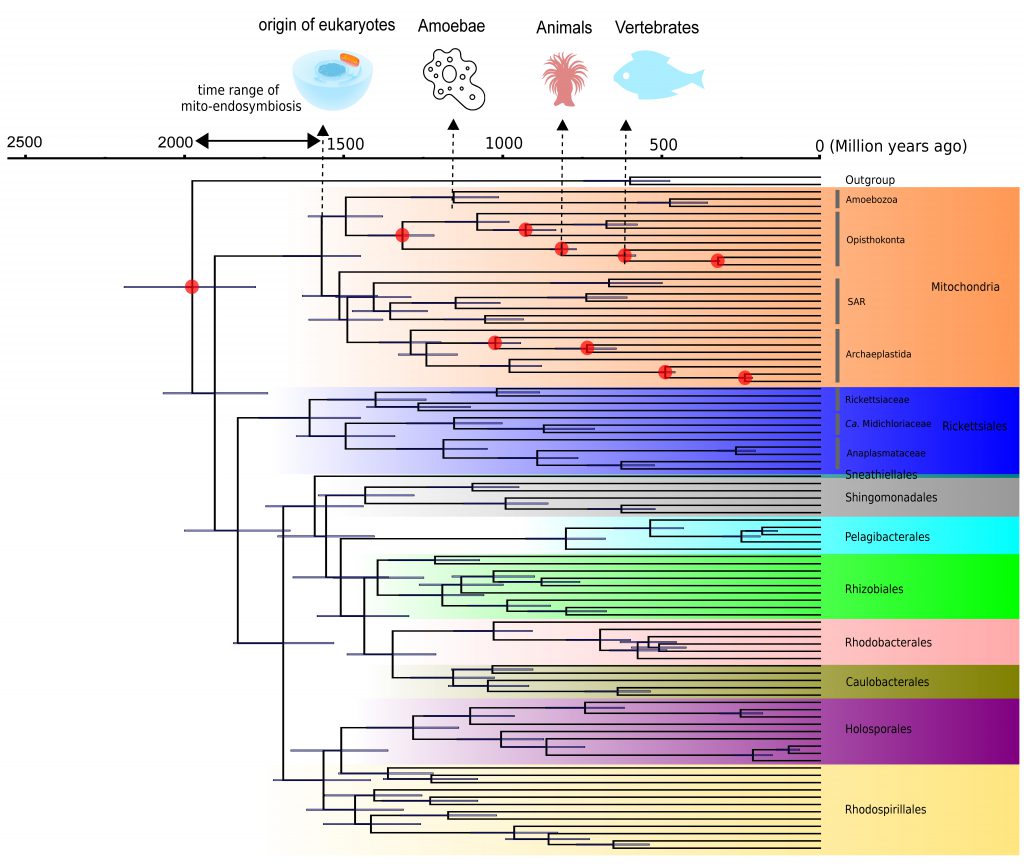CUHK
News Centre
CUHK Discovers Eukaryotic Fossils Hold the Key to the Evolution Timeline of Bacteria
A new computational strategy has been developed by researchers from the School of Life Sciences at The Chinese University of Hong Kong (CUHK) to date the origin and diversification of alphaproteobacteria by using information from fossils of eukaryotes. This represents important progress in timing bacterial evolution which may also bring new insights into the emergence of pathogenic bacteria. This work has recently been published in the prestigious scientific journal Nature Communications.
For the first two-thirds of the Earth’s history, life exists only in microbial forms. Establishing the evolutionary timeline of microbial life is thus of great importance in understanding their evolution. Since divergence in genome sequences accumulates over time, scientists can estimate the divergence time of species by comparing their divergence in DNA or protein sequences. This is made successful by an approach called molecular clock, which assumes an approximately constant substitution rate over time.
For many eukaryotic organisms like animals or plants, calibrating the molecular clock can often be informed by their abundant fossil records. This task, however, becomes very challenging as fossils for these soft-body microorganisms are extremely difficult to preserve.
In a new study conducted by Professor Haiwei LUO, Associate Professor, and Dr. Sishuo WANG, Post-doctoral Fellow, School of Life Sciences at CUHK, a new approach to date the evolution of alphaproteobacteria has been developed. Alphaproteobacteria are one of the most abundant bacterial groups across the oceans and soils, and they have formed an intimate association with animals (e.g., rickettsia) and plants (e.g., rhizobia), making them a promising system for investigating the timing of bacterial evolution and their links to important geological, ecological, and evolutionary events.
The study is based on the famous mitochondria endosymbiosis which posits that mitochondria in eukaryotic organisms originated from an alphaproteobacterial lineage. Briefly, Professor LUO and Dr. WANG built the phylogenetic tree showing the evolutionary relationships among alphaproteobacterial groups and mitochondria, and transferred the time information recorded by eukaryotic fossils to anchor the time at which alphaproteobacteria and their major clades evolved.
The research team showed that this approach compensates for the absence of fossils in alphaproteobacteria, and circumvents the limitations of traditional methods which are mostly based on indirect evidence for calibration. Prior studies calibrated the evolution of pathogenic bacteria according to the divergence time of their modern hosts which, however, might ignore the possibility of the shift in host during bacterial evolution. By using the newly developed approach which co-estimates the origin times of both symbiotic bacteria (including many parasites) and their eukaryotic hosts, the team showed that the origin of Rickettsiales, best known as animal pathogens, largely predates the emergence of animals but coincides with the origin of protists (tiny eukaryotic organisms such as amoeba and ciliates). This, combined with further analyses, suggested multiple host shifts from protists to animals during Rickettsiales evolution, reminding people to pay attention to unicellular eukaryotes, which could be potential reservoirs from which human pathogens emerge.
Professor LUO explained, “Calibrating the molecular clock with accurate dating information is one of the most challenging tasks in building a “time-calibrated phylogenetic tree”. Our research finding holds promise for dating any phylogenies involving endosymbiosis events. These include the mitochondrial endosymbiosis, plastid endosymbiosis giving rise to the plant lineage, and the so-called secondary and tertiary endosymbioses which likely occurred multiple times in eukaryotes. Because of the importance of these endosymbiosis events, the strategy developed by the research team opens a new window for understanding the evolution of the microbial tree of life.”
The full text of the research paper can be found at: https://www.nature.com/articles/s41467-021-23645-4. This work is supported by Hong Kong Research Grants Council Area of Excellence Scheme (AoE/M-403/16) and Hong Kong Branch of Southern Marine Science and Engineering Guangdong Laboratory (Guangzhou) (SMSEGL20SC02).
About the research team
Professor Haiwei LUO, who joined CUHK in 2015, is a member of State Key Laboratory of Agrobiotechnology at CUHK. His major research interest is using genomic approaches to study microbial evolution and adaptation in marine and terrestrial ecosystems. He is broadly interested in the ecology and evolution of key microbial lineages that drive carbon, nitrogen and sulfur cycles. Some of his research findings have important implications for marine conservation and agricultural productivity.
Dr. Sishuo WANG obtained his PhD at the University of British Columbia in 2017, after which he joined Professor LUO’s lab at CUHK as a postdoc to study bacterial evolution and genomics. He is a recipient of the Impact Postdoctoral Fellowship and the Research Fellowship Scheme by CUHK. His research has been published in the journals Nature Communications, The ISME Journal, mBio, and mSystems.




